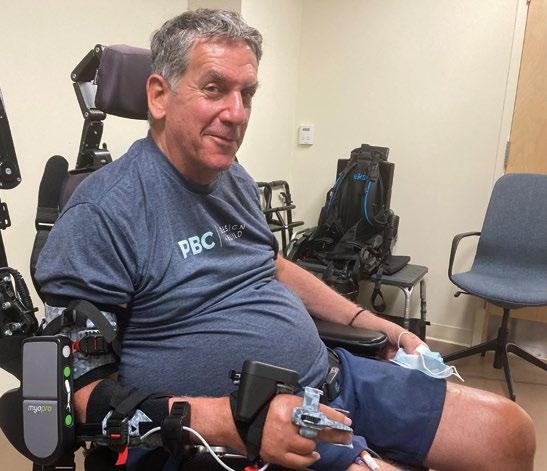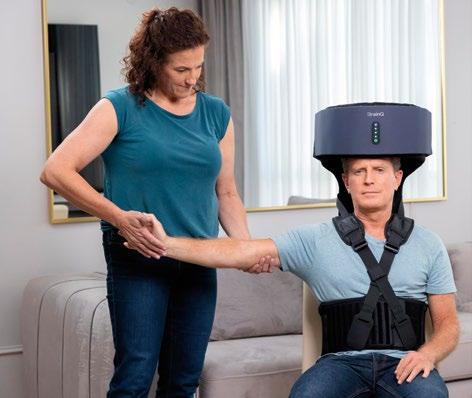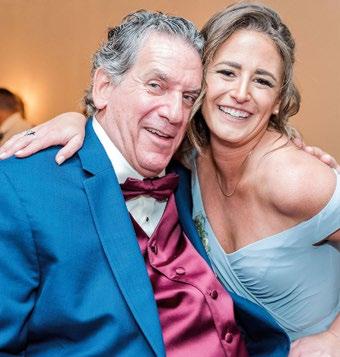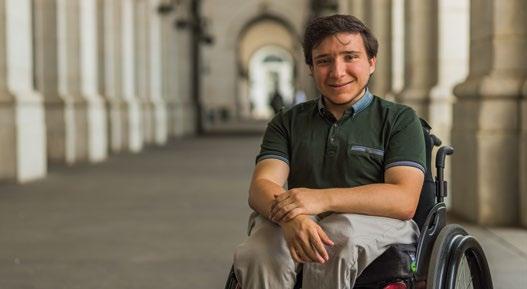Your support maximizes recovery, independence, and inclusion for people with disabilities.
Changing the lives of people with disabilities


Your support maximizes recovery, independence, and inclusion for people with disabilities.

establishes his professional path thanks to you (see pg. 4).
Spring 2023 Issue No. 16
Applying Innovative Technologies Advances Rehabilitation of the Upper Extremity, Thanks to Your Support
Regaining the use of hands and arms makes an enormous difference to people striving to overcome disabling injuries and illnesses. “Small gains in function can mean big improvements in the everyday lives of people who have lost full use of their hands and arms— what we refer to as the upper extremity,” according to Ghaith Androwis, PhD, senior research scientist at Kessler Foundation’s Center for Mobility and Rehabilitation Engineering Research. With your generosity, Dr. Androwis is investigating exciting approaches to upper extremity rehabilitation for people with spinal cord injury and stroke.
Half of all spinal cord injuries cause loss of function of the upper and the lower extremities, complicating the pathway to recovery. In individuals with spinal cord injury, Androwis’s team evaluated a wearable robotic brace called MyoPro (Myomo, Inc., Boston, MA). Light in weight and usable in various settings, the brace contains sensors that detect the user’s intention to move their muscles. “This gives the person voluntary control over their movements—an important feature,” says Dr. Androwis. “Having an active role in moving the hand and arm with intention is critical for recovering motor control,” he emphasizes.

“Thanks to your support, we saw increases in handgrip grip force, range of motion, and muscle activation, and shorter times needed to initiate movement in individuals with SCI.”
“After just six weeks of therapy, we saw increases in handgrip grip force, range of motion, and muscle activation, and shorter times needed to initiate movement,” he reports. “For one participant, Ted Talis, these gains meant being able to operate a TV remote, better control his wheelchair, and hold a bottle and drink from it. These results point to the potential for MyoPro for rehabilitation, as well as for at-home use,”
Dr. Androwis explains.
Dr. Androwis has expanded this research, combining MyoPro therapy with real-time feedback using virtual reality. “Combining technologies may enhance functional recovery,” he explains, “which could positively impact the health and welfare of people with spinal cord injury, including members of our military and veterans.”
Another experimental device also shows promise
–Ghaith
Androwis, PhD
for restoring upper extremity function. BrainQ (BrainQ Technologies Ltd., Jerusalem, Israel), fits over the head and torso, delivering electromagnetic stimulation to the brain and spinal cord while the participant exercises their hand and arm following instructions presented on the system’s tablet. Because of promising early findings in individuals recovering from stroke, the FDA has designated BrainQ as a ‘Breakthrough Device,’ fast-tracking research.
“BrainQ is able to ‘fill in’ for nerve signals lost to spinal cord injury or stroke,” Dr. Androwis explains.
“By using artificial intelligence and machine learning, the device ‘tricks’ the nervous system by providing the missing signals needed to complete repetitive motor tasks. With time and repetition, this helps re-establish functional nerve pathways, improving voluntary use of the hand and arm.”
Early findings in individuals with spinal cord injury were encouraging, with meaningful gains in upper extremity strength and function, according to Dr. Androwis.
“One participant reported writing his own name for the first time since his injury and using a fork to feed himself,” he notes.
Researchers are now testing BrainQ in inpatients undergoing rehabilitation for acute stroke at Kessler Institute for Rehabilitation as part of a national trial.
“With BrainQ, we can not only start therapy right after stroke, but we can also continue sessions throughout rehabilitation and in the home setting,” notes Dr. Androwis, “providing the early and
intensive intervention that is so important to recovery.”
This research underscores the neuroplasticity of the nervous system, showing the potential for recovery after a disabling loss of function. Although these early studies are promising, now larger studies are needed to determine how best to apply these approaches in clinical care and at home. “Much work still needs to be done,” summarizes Dr. Androwis, “but we have succeeded in highlighting the pressing needs of individuals with these disabilities and raising awareness of the tremendous potential for improving their lives and those of their caregivers.”

Retired cybersecurity executive, father of three, and spinal cord injury survivor Ted Talis is on a recovery mission.
In August 2019, Ted was enjoying more time with his family and a second career in real estate when, late one evening after work, he tripped on the front steps leading to his house. “I tried to regain my footing but fell backward and landed in the driveway,” recounts Ted.
“I laid there the entire night, unable to reach my phone to call for help. A friend found me the next morning.”
Ted had sustained a spinal cord injury. After weeks in the hospital, he transferred to Kessler Institute for Rehabilitation, where he began his recovery and regained some movement in his left hand and arm.
“After three months, my right hand, however, remained frozen in a claw shape,” recalls Ted.
During rehabilitation, Ted heard about groundbreaking research at Kessler Foundation, made possible by your generous support.
“I joined multiple studies. The third study, working with Dr. Ghaith Androwis and the MyoPro robot, changed my life.”


Ted found it intriguing to use his intentions while training in the wearable robotic brace.
“Using my thoughts to move my upper body was miraculous and empowering,” Ted reports.
“The physical therapist on Dr. Androwis’s team advised it might take six weeks to learn how to activate movements, but I made it my mission to do better. When the study concluded, I could grasp and throw a ball with my once-locked right hand,” declares Ted.
Today, with greatly improved upper extremity mobility, especially in his right hand and fingers, Ted lives a more independent life.
“I’m enjoying retirement and able to drive myself again.
I’m grateful to Kessler Foundation and the donors who support this life-changing research so that I can continue my mission,” concludes Ted.
Listen to a special message from Ted
Political science major Christopher Rosati does not let the fact he was born with spina bifida or uses a wheelchair for mobility stop him— especially when it comes to pursuing his passion for public policy and government service. Because of your generosity, he experienced what a career in Washington, D.C. might be like and established a path toward his professional future.
Christopher, a graduating senior at the College of New Jersey, was awarded The Washington Center’s Leadership Initiative Scholarship for Students with Disabilities.
The Scholarship, funded by Kessler Foundation, thanks to your support,
provides immersive internships to college students with disabilities, helping young people pursue their aspirations.
“I’ve always had an interest in public policy, but working on Capitol Hill solidified my resolve,”
Christopher shares.
“My experience working with U.S. House of Representative Chris Smith was an invaluable opportunity to gain skills, open doors, and expand my network—all crucial to starting out on the Hill,” adds Christopher.
“While my disability can often affect everything I do, I didn’t feel it got in the way of the work I accomplished,” explains Christopher.
All of us at Kessler Foundation know you value rehabilitation research and employment for people with disabilities. Your continued generosity will inspire discovery and innovation for people like Ted Talis, Christopher Rosati, and others striving to recover and fulfill their dreams. Thank you. Your continued support will mean more research, more advancements, and more independence.

Learn

Representative Smith (R-Manchester, NJ) is a household name for the Rosati family because of his past work on the Congressional Spina Bifida Caucus. “I have a picture of Chris and me at a spina bifida awards event when I was four or five years old. Working for him, I’ve come full circle,” Christopher explains.
The internship has inspired Christopher to apply for a Master of Public Policy program at his alma mater. “I may run for office one day or work full-time in D.C. One of my goals is to use the channels of government to ensure that public spaces can be used by people of all abilities— right now the world is not the most accessible place,” he asserts.